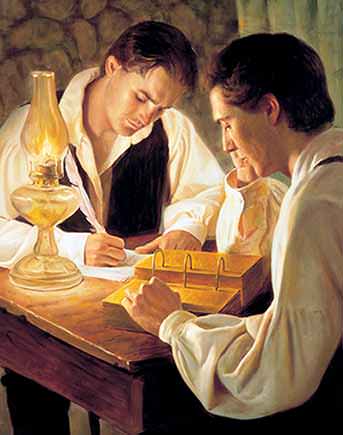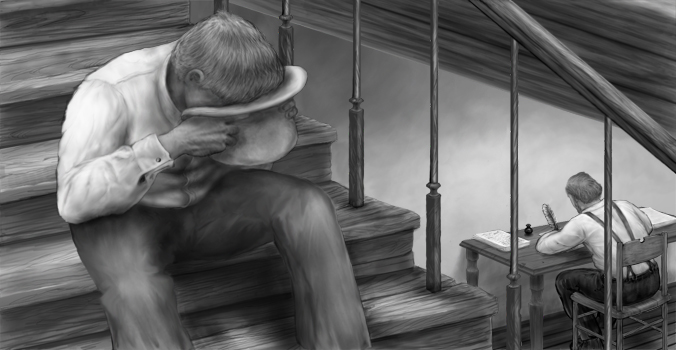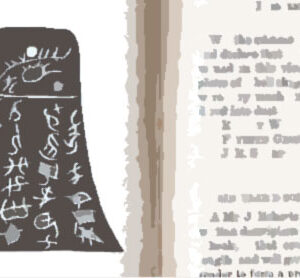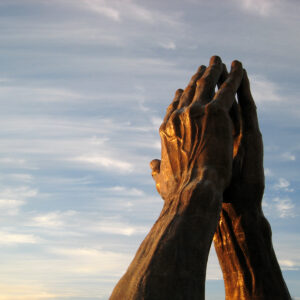1. Book of Mormon Translated with a Peep Stone: Contrary to general Church teachings, Joseph Smith did not use the gold plates in translating the Book of Mormon. Rather, he used a rock in a hat to translate the plates into the Book of Mormon. The Church acknowledged this fact in its December 2013 essay, entitled Book of Mormon Translation, published on LDS.org. There were numerous witnesses to Joseph Smith’s translation of the Book of Mormon. They all tell essentially the same story: while Joseph and his brother were employed as a treasure seekers (commonly referred to as a “money diggers”), he found a peep stone or “seer stone” while digging a well on Willard and Mason Chase’s property. Joseph later used this same stone to translate the Book of Mormon. Specifically, Joseph put the stone in a hat and then, burying his face in the hat, proceeded to dictate the Book of Mormon to his scribe. Joseph claimed to see the words he dictated in the darkened hat. However, during the entirety of the translation process, the gold plates were either covered in a cloth where no one, including Joseph, could see them or they were in a different room or location during the translation process.
- Emma Hale Smith, Joseph’s wife, was the first person to serve as Joseph’s scribe. Here is her testimony as recounted to her son Joseph Smith III: “In writing for your father I frequently wrote day after day, often sitting at the table close by him, he sitting with his face buried in his hat, with the stone in it, and dictating hour after hour with nothing between us.” The Saints Herald, Vol. 26, No. 19, p.289
- Robert N. Hullinger, in his book: Joseph Smith’s Response to Skepticism, cites a personal interview Emma Smith (then Emma Smith-Bidamon) gave in 1879 to a committee of the Reorganized Church of Jesus Christ of Latter-day Saints. He notes on pages 9–10: “Smith’s wife Emma supported Harris’s and Whitmer’s versions of the story in recalling that her husband buried his face in his hat while she was serving as his scribe.”
- David Whitmer was one of the three witnesses of the Book of Mormon. The majority of the translation work took place in the Whitmer home. Whitmer stated:
“I will now give you a description of the manner in which the Book of Mormon was translated. Joseph Smith would put the seer stone into a hat, and put his face in the hat, drawing it closely around his face to exclude the light; and in the darkness the spiritual light would shine. A piece of something resembling parchment would appear, and on that appeared the writing. One character at a time would appear, and under it was the interpretation in English. Brother Joseph would read off the English to Oliver Cowdery, who was his principal scribe, and when it was written down and repeated to Brother Joseph to see if it was correct, then it would disappear, and another character with the interpretation would appear… He [Joseph Smith] did not use the plates in translation.” REF: Page 11 of his book An Address to All Believers in Christ, Part First, Chapter 1. Also, Interview given to Kansas City Journal, June 5, 1881, reprinted in the Reorganized Church of Jesus Christ of Latter Day Saints Journal of History, vol. 8, (1910), pp. 299–300.
- Martin Harris, who served as a scribe for the lost 116 pages as well as one of the witnesses to the Book of Mormon, confirmed that Joseph used a seer stone (as opposed to the Urim and Thummim) during the translation process. In his Comprehensive History of the Church (“CHC”), LDS historian and President of the First Quorum of the Seventy B.H. Roberts quotes Martin Harris as saying that Joseph’s seer stone was a “chocolate-colored, somewhat egg-shaped stone which the Prophet found while digging a well in company with his brother Hyrum.” Harris went on to say it was by using this stone that “Joseph was able to translate the characters engraven on the plates” (CHC 1:129).
In other words, Joseph used the same methods he used in his treasure-hunting: he would put the rock – or a peep stone – in his hat and then put his face in the hat to tell his customers the location of buried treasure. He used the exact same method while the gold plates were covered or put in another room or buried in the woods while translating the Book of Mormon. These facts are confirmed in “Rough Stone Rolling” (p. 71–72), by FAIR here and here, by Neal Maxwell Institute (FARMS), as well as in a 1992 talk given by Russell M. Nelson of the Quorum of the Twelve Apostles.
2. Church Has Not Accurately Taught the BOM Translation Process: The translation process described above (as well as in an October 2015 Ensign article) is odd for a variety of reasons. For the last century, the Church has rarely discussed the details of the translation process and, when it has, it has not done so in an honest manner. Prior to the October 2015, the Ensign only printed quotes discussing Joseph’s rock-in-the-hat translation on two occasions — in July 1993 and September 1977. Even now, church manuals publish images depicting Joseph Smith translating the BOM with the gold plates directly in front of him and usually without any seeing devices present. For example, the following are depictions of how the Church portrays the translation process:


The following is a depiction of how the Book of Mormon was actually translated:

Simply stated, the Church does not teach members how Joseph Smith actually translated the Book of Mormon.
3. Urim and Thummim: The Church’s representations regarding the Urim and Thummim are also misleading. Specifically, the Urim and Thummim, the very instrument preserved by the Nephites in a stone box for thousands of years for the sole purpose of translating the plates, was not used to translate the Book of Mormon as the church claims. The Urim and Thummim, described as a set of stones set in a pair of spectacles fastened to a breastplate, were taken away by the angel Moroni when Joseph lost the first 116 pages of the Book of Mormon and were never returned.
In fact, the Urim and Thummim was never mentioned by Joseph with reference to translating the Book of Mormon until after 1833, some three years after the Book of Mormon was published. In 1833, W.W. Phelps, speculated that the ancient Nephite interpreters mentioned in the Book of Mormon might be the Urim and Thummim of the Old Testament. Phelps’ speculation quickly became popular to the point where the Church re-wrote passages in the Doctrine and Covenants to make sure that the seer stones were always referred to as the Urim and Thummim. David Whitmer, however, in an 1885 interview with the RLDS Saints’ Herald, stated that the entire Book of Mormon text came through Joseph’s seer stone and not through the Nephite interpreters.
Regardless, there is no evidence the Urim & Thummim mentioned in the Old Testament was a translation device. The object is mentioned seven times in the Old Testament (Exodus 28:30; Leviticus 8:8; Ezra 2:63; Nehemiah 7:65; Deuteronomy 33:8; Numbers 27:21; 1 Samuel 28:6; in the latter two passages “Urim” is used alone). The Urim & Thummim described in the Old Testament appears to more of a ‘Yes/No’ tool like a pair of dice rather than an actual translation device. I have not found any evidence that the Biblical Urim and Thummim had anything to do with “translating languages”, or that they resembled “giant spectacles” as Book of Mormon witnesses claimed.
4. Gold Plates Not Used During Translation: The golden plates, which were carefully and painstakingly made and cared for over thousands of years, were never used in the translation process. Rather, according to the witnesses, the plates were always covered in a cloth or not even in the room when the translation was taking place. Regardless, even if they were in the same room and uncovered, Joseph couldn’t see the plates when his face was buried in a hat.
Joseph Smith’s translation process raises a number of questions. Most notably, why did ancient prophets painstakingly record their actions on golden plates for over a thousand years when the plates were not even used during the “translation” process? If God simply revealed the writings from the plates to Joseph through a stone, why have the plates at all? God or Moroni could have simply revealed the history of the earliest Americans without the worry of protecting the golden plates that Joseph claimed to have unearthed in the Hill Cumorah.
5. Translation Timeline Raises Additional Concerns: In 1822, Joseph Smith found a peep stone while digging a well and then began using it as part of a career to find lost treasure. In fact, Joseph used the stone as part of a treasure-seeking business in which clients paid him to look into the stone to find lost treasure (which, it should be added, he was never able to find). Several clients testified that Joseph looked into the stone and claimed that the treasure was close but, upon arriving at its location, Joseph would claim that it slipped out of reach so that no one could obtain it, let alone see it.
In 1826, Joseph was arrested and brought to court in Bainbridge, New York, for trial for fraud. He was arrested after Josiah Stowell’s nephew accused Joseph of being a “disorderly person and an imposter.” Specifically, Joseph was charged with seeking lost treasure under false pretenses (i.e., that he was guided through supernatural powers and a special peep stone). Joseph was convicted of the crime, which was a misdemeanor. A copy of the judgment, which is reproduced and discussed in the Book of Mormon Witnesses section, referred to Joseph as “The Glass Looker.”
In 1827, Joseph said he received the gold plates from Moroni and was told that no one was allowed to see them. By 1829, Joseph finished “translating” the BOM and he then returned the plates to Moroni. Eleven witnesses claim they saw the plates, but most of them (as discussed in the Book of Mormon Witnesses section) admit they didn’t see them with their natural eyes.
The foregoing timeline casts doubt on Joseph’s motives and methods for producing the Book of Mormon. In fact, it seems as if the gold plates and interpreters were merely an extension of Joseph’s treasure-hunting and peep stone activities.
6. Translation Process Raises Troubling Questions: If Joseph Smith did receive the Book of Mormon text through his peep stone, then the text presumably came directly from God via revelation. (Plus, Joseph Smith called it the most correct book on earth.) If this is the case, why were so many changes made to Book of Mormon text? (For a more complete analysis of the changes made to the BOM, see the Book of Mormon section of this outline.) For example, early editions of the Book of Mormon taught a Trinitarian view of the Godhead before subsequent revisions altered the text. Joseph Smith’s early theology (even after the First Vision) also subscribed to the doctrine of the Trinity. Including minor grammatical changes, the Book of Mormon has undergone over 100,000 changes and at least 3,913 substantive changes. However, some of those changes were quite significant and made to reflect Joseph’s evolving view of the Godhead.
If the BOM text was received via revelation, why does it contain so many anachronisms and refer to so many objects and animals that did not exist in the Americas during BOM times?
If the BOM was received through revelation, why does it contain numerous errors found in the 1769 KJV edition of the Bible, which Joseph Smith owned but was published long after the BOM was allegedly written? These errors suggest that Joseph copied portions of the Bible and inserted them into the Book of Mormon. Moreover, why does the BOM contain numerous other errors?



Leave a Reply